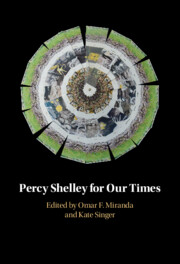Book contents
- Percy Shelley for Our Times
- Reviews
- Percy Shelley for Our Times
- Copyright page
- Contents
- Notes on Contributors
- Acknowledgments
- Abbreviations
- Introduction
- 1 Shelley, Treaty-Making, and Indigenous Poetry
- 2 Waiting for the Revolution
- 3 “A Chamæleonic Race”
- 4 Dream Defenders and the Inside Songs
- 5 Radical Suffering
- 6 Loathsome Sympathy
- 7 Hopeless Romanticism
- 8 Percy Shelley’s Sad Exile
- 9 Shelley in the Overgrowth
- 10 Creatrix Witches, Nonbinary Creatures, and Shelleyan Transmedia
- 11 Action at a Distance
- 12 Educating the Imagination/Defending Shelley Defending
- Further Reading
- Index
4 - Dream Defenders and the Inside Songs
Published online by Cambridge University Press: 07 March 2024
- Percy Shelley for Our Times
- Reviews
- Percy Shelley for Our Times
- Copyright page
- Contents
- Notes on Contributors
- Acknowledgments
- Abbreviations
- Introduction
- 1 Shelley, Treaty-Making, and Indigenous Poetry
- 2 Waiting for the Revolution
- 3 “A Chamæleonic Race”
- 4 Dream Defenders and the Inside Songs
- 5 Radical Suffering
- 6 Loathsome Sympathy
- 7 Hopeless Romanticism
- 8 Percy Shelley’s Sad Exile
- 9 Shelley in the Overgrowth
- 10 Creatrix Witches, Nonbinary Creatures, and Shelleyan Transmedia
- 11 Action at a Distance
- 12 Educating the Imagination/Defending Shelley Defending
- Further Reading
- Index
Summary
“Dream Defenders and the Inside Songs” explores the extent to which Percy Shelley's poetic legislation is able to counter racial divisiveness and antiBlackness in “our” communities and universities. It enlists Fred Moten’s poem “barbara lee” and Benjamin Zephaniah’s characterization of Shelley as the “original dub poet” to claim that what is “wholly political” about the semantic and sonic relays activated in Shelleyan songs is their capacity to disrupt the associational logics undergirding white-body supremacy and literary Anglo-Eurocentrism. Tracking the process enacted in “barbara lee,” by which reliance on “the inside songs” enables Representative Lee to vote against President Bush’s military authorization act, the chapter proposes some pedagogical and creative-critical revisions to Shelley studies that might effect a similar “inside outward opening” of Shelley. Leftist celebrations of “Red Shelley” have emphasized the collective and street-performative dimensions of his then-unpublished protest songs. The chapter probes the salience of a “black” Shelley by recasting two familiar Shelleyan devices. One emphasizes sound’s activation of embodied knowledge that circumvents the priority granted to textual literacy. A second accentuates association as a process that expands the affective-cognitive connections mobilized by a word and by encounters with another person. In other words, the intimacy between who we know and what we know is an underacknowledged fact of scholarly method. Diversifying one is key to diversifying the other in an ongoing cycle. Cultivating the two promises to transform “defenses” of poetry into live performances of antiracism.
- Type
- Chapter
- Information
- Percy Shelley for Our Times , pp. 85 - 107Publisher: Cambridge University PressPrint publication year: 2024

